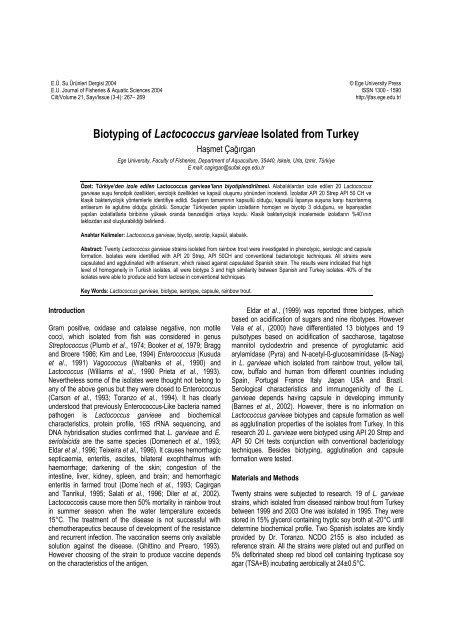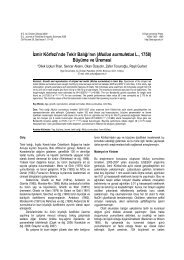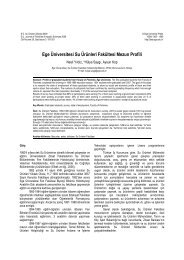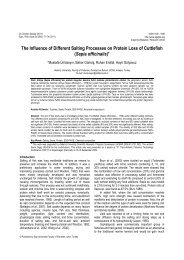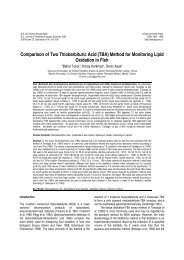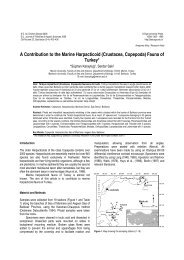Biotyping of Lactococcus garvieae Isolated from Turkey - Journal of ...
Biotyping of Lactococcus garvieae Isolated from Turkey - Journal of ...
Biotyping of Lactococcus garvieae Isolated from Turkey - Journal of ...
Create successful ePaper yourself
Turn your PDF publications into a flip-book with our unique Google optimized e-Paper software.
E.Ü. Su Ürünleri Dergisi 2004<br />
E.U. <strong>Journal</strong> <strong>of</strong> Fisheries & Aquatic Sciences 2004<br />
Cilt/Volume 21, Sayı/Issue (3-4): 267– 269<br />
© Ege University Press<br />
ISSN 1300 - 1590<br />
http://jfas.ege.edu.tr/<br />
<strong>Biotyping</strong> <strong>of</strong> <strong>Lactococcus</strong> <strong>garvieae</strong> <strong>Isolated</strong> <strong>from</strong> <strong>Turkey</strong><br />
Haşmet Çağırgan<br />
Ege University, Faculty <strong>of</strong> Fisheries, Department <strong>of</strong> Aquaculture, 35440, Iskele, Urla, Izmir, Türkiye<br />
E mail: cagirgan@sufak.ege.edu.tr<br />
Özet: Türkiye’den izole edilen <strong>Lactococcus</strong> <strong>garvieae</strong>’ların biyotiplendirilmesi. Alabalıklardan izole edilen 20 <strong>Lactococcus</strong><br />
<strong>garvieae</strong> suşu fenotipik özellikleri, serolojik özellikleri ve kapsül oluşumu yönünden incelendi. İzolatlar API 20 Strep API 50 CH ve<br />
klasik bakteriyolojik yöntemlerle identifiye edildi. Suşların tamamının kapsullü olduğu, kapsullü İspanya suşuna karşı hazırlanmış<br />
antiserum ile aglutine olduğu görüldü. Sonuçlar Türkiyeden yapılan izolatların homojen ve biyotip 3 olduğunu, ve İspanyadan<br />
yapılan izolatlatlarla biribirine yüksek oranda benzediğini ortaya koydu. Klasik bakteriyolojik incelemede izolatların %40’ının<br />
laktozdan asit oluşturabildiği belirlendi.<br />
Anahtar Kelimeler: <strong>Lactococcus</strong> <strong>garvieae</strong>, biyotip, serotip, kapsül, alabalık.<br />
Abstract: Twenty <strong>Lactococcus</strong> <strong>garvieae</strong> strains isolated <strong>from</strong> rainbow trout were investigated in phenotypic, serologic and capsule<br />
formation. Isolates were identified with API 20 Strep, API 50CH and conventional bacteriologic techniques. All strains were<br />
capsulated and agglutinated with antiserum, which raised against capsulated Spanish strain. The results were indicated that high<br />
level <strong>of</strong> homogeneity in Turkish isolates, all were biotype 3 and high similarity between Spanish and <strong>Turkey</strong> isolates. 40% <strong>of</strong> the<br />
isolates were able to produce acid <strong>from</strong> lactose in conventional techniques<br />
Key Words: <strong>Lactococcus</strong> <strong>garvieae</strong>, biotype, serotype, capsule, rainbow trout.<br />
Introduction<br />
Gram positive, oxidase and catalase negative, non motile<br />
cocci, which isolated <strong>from</strong> fish was considered in genus<br />
Streptococcus (Plumb et al., 1974; Booker et al, 1979; Bragg<br />
and Broere 1986; Kim and Lee, 1994) Enterococcus (Kusuda<br />
et al., 1991) Vagococcus (Walbanks et al., 1990) and<br />
<strong>Lactococcus</strong> (Williams et al., 1990 Prieta et al., 1993).<br />
Nevertheless some <strong>of</strong> the isolates were thought not belong to<br />
any <strong>of</strong> the above genus but they were closed to Enterococcus<br />
(Carson et al., 1993; Toranzo et al., 1994). It has clearly<br />
understood that previously Enterococcus-Like bacteria named<br />
pathogen is <strong>Lactococcus</strong> <strong>garvieae</strong> and biochemical<br />
characteristics, protein pr<strong>of</strong>ile, 16S rRNA sequencing, and<br />
DNA hybridisation studies confirmed that L. <strong>garvieae</strong> and E.<br />
seriolaicida are the same species (Domenech et al., 1993;<br />
Eldar et al., 1996; Teixeira et al., 1996). It causes hemorrhagic<br />
septicaemia, enteritis, ascites, bilateral exophthalmus with<br />
haemorrhage; darkening <strong>of</strong> the skin; congestion <strong>of</strong> the<br />
intestine, liver, kidney, spleen, and brain; and hemorrhagic<br />
enteritis in farmed trout (Dome´nech et al., 1993; Cagirgan<br />
and Tanrikul, 1995; Salati et al., 1996; Diler et al., 2002).<br />
Lactococcosis cause more then 50% mortality in rainbow trout<br />
in summer season when the water temperature exceeds<br />
15°C. The treatment <strong>of</strong> the disease is not successful with<br />
chemotherapeutics because <strong>of</strong> development <strong>of</strong> the resistance<br />
and recurrent infection. The vaccination seems only available<br />
solution against the disease. (Ghittino and Prearo, 1993).<br />
However choosing <strong>of</strong> the strain to produce vaccine depends<br />
on the characteristics <strong>of</strong> the antigen.<br />
Eldar et al., (1999) was reported three biotypes, which<br />
based on acidification <strong>of</strong> sugars and nine ribotypes. However<br />
Vela et al., (2000) have differentiated 13 biotypes and 19<br />
pulsotypes based on acidification <strong>of</strong> saccharose, tagatose<br />
mannitol cyclodextrin and presence <strong>of</strong> pyroglutamic acid<br />
arylamidase (Pyra) and N-acetyl-ß-glucosaminidase (ß-Nag)<br />
in L. <strong>garvieae</strong> which isolated <strong>from</strong> rainbow trout, yellow tail,<br />
cow, buffalo and human <strong>from</strong> different countries including<br />
Spain, Portugal France Italy Japan USA and Brazil.<br />
Serological characteristics and immunogenicity <strong>of</strong> the L.<br />
<strong>garvieae</strong> depends having capsule in developing immunity<br />
(Barnes et al., 2002). However, there is no information on<br />
<strong>Lactococcus</strong> <strong>garvieae</strong> biotypes and capsule formation as well<br />
as agglutination properties <strong>of</strong> the isolates <strong>from</strong> <strong>Turkey</strong>. In this<br />
research 20 L. <strong>garvieae</strong> were biotyped using API 20 Strep and<br />
API 50 CH tests conjunction with conventional bacteriology<br />
techniques. Besides biotyping, agglutination and capsule<br />
formation were tested.<br />
Materials and Methods<br />
Twenty strains were subjected to research. 19 <strong>of</strong> L. <strong>garvieae</strong><br />
strains, which isolated <strong>from</strong> diseased rainbow trout <strong>from</strong> <strong>Turkey</strong><br />
between 1999 and 2003 One was isolated in 1995. They were<br />
stored in 15% glycerol containing tryptic soy broth at -20°C until<br />
determine biochemical pr<strong>of</strong>ile. Two Spanish isolates are kindly<br />
provided by Dr. Toranzo. NCDO 2155 is also included as<br />
reference strain. All the strains were plated out and purified on<br />
5% defibrinated sheep red blood cell containing trypticase soy<br />
agar (TSA+B) incubating aerobically at 24±0.5°C.
268 Çağırgan / E.Ü. Su Ürünleri Dergisi 21 (3-4): 267-269<br />
API 20 Strep test and API 50 CH tests (Biomerieux,<br />
France) were used to determine biochemical characteristics <strong>of</strong><br />
bacteria according to the manufacturer instruction except<br />
incubation temperature, which was 24±0.5°C. All strains were<br />
spectrophotometrically adjusted (Optic density 0.8 at 580 nm<br />
wave length) inocula prepared <strong>from</strong> TSA+B grown colony.<br />
Blood degradation was determined on TSA+B incubating<br />
aerobically at same temperature incubating for 2 days<br />
(Falclam and Elliott, 1995). For catalase test one drop <strong>of</strong> 3%<br />
hydrogen peroxide was mixed with Trypticase soy agar (TSA)<br />
(Caso agar, Merck) grown colony on a slide. Oxidase test was<br />
performed with TSA grown colony streaking to Merck Strip<br />
(Merck) growth at pH 9.6 was tested in brain hearth infusion<br />
broth (BHIB, Merck) Salt tolerance tests were performed in<br />
6.5% NaCl and bromcresol purple (BCP) containing brain<br />
hearth infusion broth (BHIB, Merck) incubating up to 14 days.<br />
Oxidation and fermentation test (OF) were carried out in<br />
modified OF medium (Koneman et al.,1992; Falcklam and<br />
Elliott, 1995) Growth at 10°C and 45°C were tested in 0.1%<br />
dextrose and BCP added BHIB. Acid formation <strong>from</strong> lactose,<br />
sorbitol, D-arabinose, melibiose, rhamnose, inositol, inuline<br />
were also determined in BCP and sugar added BHIB<br />
incubating up to 2 weeks according to the method <strong>of</strong> Faclam<br />
and Elliott (1995). Voges proscourer (VP) and methyl red<br />
(MR) were tested in VP-MR medium (Merck).<br />
Slide agglutination tests were carried out with all isolated<br />
strains using raised rabbit serum against capsulated Spanish<br />
isolate (279) (Toranzo et al., 1987). Capsule formation was<br />
also determined by the method <strong>of</strong> Pr<strong>of</strong>. J. Romalde (Personal<br />
communication). One TSB+B grown colony suspended in<br />
PBS (pH 7.4) and fixed with equal volume <strong>of</strong> fixing solution<br />
(2.5% glutaraldehyde containing 100 mM L-lysine HCL,<br />
Merck) for 20 minutes at room temperature. A loopfull<br />
suspension put on a slide and air-dried. Then stained with 3<br />
minutes with basic fuchsine and investigated with light<br />
microscope. Red stained bacteria which surrounded by<br />
unstained halo is capsule positive.<br />
Result and Discussion<br />
Lactococcosis is causing high level <strong>of</strong> mortality in many<br />
countries (Austin and Austin, 1999) While Vela et al., (2000)<br />
were reporting 13 biotypes <strong>of</strong> L. <strong>garvieae</strong>, which isolated <strong>from</strong><br />
different countries and species, Eldar et al. (1999) were<br />
reported three biotypes. Spanish strains were Biotype 3. In<br />
this research all strain were Gram positive 2-10 ovoid cocci<br />
containing chains, α haemolytic on TSA+B. Oxidase, catalase,<br />
gelatine degradation, H2S production, urea degradation, indol<br />
production, nitrate reduction and motility tests were negative.<br />
O/F test were positive and sensitive to O/129, and were able<br />
to growth in 6.5% NaCl containing medium as well as at pH<br />
9.6. All strains were positive in VP when tested in API 20<br />
Strep test, lately positive (2-4 days) in conventional<br />
techniques at same temperature. Acid production <strong>from</strong><br />
galactose, amygdaline (Weak in API 20 Strep, strong positive<br />
50 CHL), D-tagatose, gluconate were weakly positive. API<br />
pr<strong>of</strong>iles <strong>of</strong> Spanish strains were the same with Turkish strains.<br />
8 strains (40%) were produced acid <strong>from</strong> lactose in 7 days<br />
incubation following the method <strong>of</strong> Faclam and Elliott, (1995).<br />
96% <strong>of</strong> Spanish strains and 20% <strong>of</strong> Taiwan were produced<br />
acid <strong>from</strong> lactose in conventional technique when blood agar<br />
grown colony tested (Ravelo et al., 2001; Chang et al., 2002)<br />
The phenotypic characteristics <strong>of</strong> isolated <strong>Lactococcus</strong><br />
<strong>garvieae</strong> strains were tabulated in Table 1.<br />
Table 1. Penotypic characteristics <strong>of</strong> <strong>Lactococcus</strong> <strong>garvieae</strong> isolated <strong>from</strong> <strong>Turkey</strong>.<br />
Phenotypic tests<br />
Phenotypic tests<br />
Catalase - (20/20) L-Sorbose -(20/20)<br />
Oxidase - (20/20) L-Rhamnose -(20/20)<br />
H2S - (20/20) Dulcitol -(20/20)<br />
Urease - (20/20) Inositol -(20/20)<br />
Citrate - (20/20) D-Mannitol +(20/20)<br />
Nitrate - (20/20) D-Sorbitol -(20/20)<br />
Motility - (20/20) Methyl-αD-Mannopyranoside -(20/20)<br />
Indol - (20/20) Methyl-αD-Glukopyranoside -(20/20)<br />
O/F test +(20/20) N-Acetyl glucosamine +(20/20)<br />
Growth in 6.5 NaCL +(20/20) Amygdaline +(20/20)<br />
Growth in pH 9.6 +(20/20) Arbutin +(20/20)<br />
Growth at 10 °C +(20/20) Esculin +(20/20)<br />
Growth at 45 °C +(20/20) Salicin +(20/20)<br />
Gelatin degradation - (20/20) D-Cellobiose +(20/20)<br />
Hemolysis α D-Maltose +(20/20)<br />
VP + (20/20) D-Lactose -(20/20)<br />
MR + (20/20) D-Lactose (Conventionel) +(8/20)<br />
Hippurat + (20/20) D-Melibiose -(20/20)<br />
Pyra + (20/20) D-Saccharose +(20/20)<br />
α galactosidase - (20/20) D-Trehalose +820/20)<br />
β Glukorinidase - (20/20) Inuline -(20/20)<br />
β Galactosidase - (20/20) D-Melezitose -(20/20)<br />
Alkaline phosphotase - (20/20) D-Raffinose -(20/20)<br />
Leucine arylamidase +(20/20) Amidon -(20/20)<br />
ADH +(20/20) Glycogene -(20/20)<br />
Glycerol -(20/20) Xylitol -(20/20)<br />
Erythritol -(20/20) Gentiobiose +(20/20)<br />
D-Arabinose -(20/20) D-Turanose -(20/20)<br />
L-Arabinose -(20/20) D-Lyxose -(20/20)<br />
D-Ribose +(20/20) D-Tagatose +(20/20)<br />
D-Xylose -(20/20) D-Fucose -(20/20)<br />
L-Xylose -(20/20) L-Fucose -(20/20)<br />
D-Adonitol -(20/20) D-Arabitol -(20/20)<br />
Methyl-βD-xylopyranoside -(20/20) L-Arabitol -(20/20)<br />
D- Galactose +(20/20) Potasium Gluconate +(20/20)<br />
D-Glucose +(20/20) Potasium 2-Ketogluconate -(20/20)<br />
D-Fructose +(20/20) Potasium 5-Ketogluconate -(20/20)<br />
D-Mannose +(19/20)<br />
All strains produced acid <strong>from</strong> sucrose, tagatose,<br />
mannitol, gluconate and Pyra, VP MR reactions were positive.<br />
Italian strains did not produce acid <strong>from</strong> either sucrose or<br />
tagatose (Vela et al., 2000). All isolated strains in this<br />
research were reduced hippurat in contrast to Italian<br />
Australian and Japanese isolates (Eldar et al., 1999). Isolates<br />
<strong>from</strong> Taiwan non-haemolytic, O/F non-fermentative, some <strong>of</strong><br />
the strain produced acid <strong>from</strong> α-methyl-D-glucoside,<br />
melesitose, glycogen and L-arabitol (Chang et al., 2002). O/F<br />
test is important to differentiate between micrococci and<br />
streptococci or staphlococci. However, some modification<br />
should be done in OF medium for cocci (Coneman et al.,1992).<br />
In this research, all <strong>of</strong> the isolated L. <strong>garvieae</strong> strains
Çağırgan / E.Ü. Su Ürünleri Dergisi 21 (3-4): 267-269 269<br />
were positive in slide agglutination using rabbit serum, which<br />
raised against capsule positive Spanish strain 279. All strains<br />
in this study were positive in capsule formation in contrary to<br />
Japanese strains (Hirono et al., 1999) Two different<br />
phenotypic pr<strong>of</strong>iles were determined in acid production <strong>from</strong><br />
lactose in conventional technique. The results showed that<br />
isolated strains <strong>from</strong> <strong>Turkey</strong> are very similar to Spanish strains<br />
and Biotype 3.<br />
References<br />
Austin, B., D. A. Austin, 1999. Bacterial fish pathogens: Diseases <strong>of</strong> Farmed<br />
and Wild Fish, 3 nd rev.ed. Praxis Publishing Ltd, Chichester, UK.<br />
Barnes A. C., C. Guyot, I., B. G. Hansen, K. Mackenzie, M. T. Horne, A. E.<br />
Ellis, 2002 Resistance to serum killing may contribute to differences in<br />
the abilities <strong>of</strong> capsulate and non-capsulated isolates <strong>of</strong> <strong>Lactococcus</strong><br />
<strong>garvieae</strong> to cause disease in rainbow trout.(Oncorhynchus mykiss<br />
L.).Fish&Shellfish Immunol. 12: 155-168.<br />
Booker, J., G. D. Jr. Imes, C. M.Cameron, T. W.Naude, H. J. Schoonbee,<br />
1979. Trout Mortalities as a result <strong>of</strong> Streptococcus Infection.<br />
Onderstepoort. J.Vet. Res. 46, 71-77.<br />
Bragg, R. R., J. S. E. Broere, 1986.Streptococcosis in Rainbow Trout in South<br />
Africa.Bull. Eur. Ass. Fish Pathol. 6 (3) 89-91.<br />
Cagirgan, H., T. T. Tanrikul, 1995. A new problem Enterococcus-like Infection<br />
in Rainbow Trout (Oncorhynchus mykiss) Farms in <strong>Turkey</strong> (in Turkish).<br />
Vet. Kont. Ve Arast. Enst. Md. Derg. C. 19, S.33: 9-19.<br />
Carson, J., N. Gudkovs, B. Austin, 1993 Characteristics <strong>of</strong> an Enterococus<br />
like Bacterium <strong>from</strong> Australia and South Africa, Pathogenic for Rainbow<br />
Trout, Oncorhynchus mykiss Walbaum. J.Fish Dis. 16: 381-388.<br />
Chang, P. H., C. M. Lin, H. Plarre (2002) <strong>Lactococcus</strong> <strong>garvieae</strong> infection <strong>of</strong><br />
cultured rainbow trout, Oncorhynchus mykiss, in Taiwan and associated<br />
biophysical characteristics and histopathology. Bull. Eur. Ass. Fish<br />
Pathol., 22(5)319-327.<br />
Diler, Ö., S. Altun, A. K. Adiloğlu, A. Kubilay, B. Işıklı, (2002) First Occurance<br />
<strong>of</strong> Streptococcosis affecting farmed rainbow trout (Oncorhynchus<br />
mykiss) in <strong>Turkey</strong>. Bull. Eur. Ass. Fish Pathol 22(1) 21-26.<br />
Domenech, A., J. Prieta, J. F. Ferna´ndez-Garayza´bal, M. D. Collins, D.<br />
Jones, L. Domý´nguez. 1993. Phenotypic and phylogenetic evidence for<br />
a close relationship between <strong>Lactococcus</strong> <strong>garvieae</strong> and Enterococcus<br />
seriolicida. Microbiologia 9: 63–68.<br />
Eldar, A., C. Ghittino, L. Asanta, E. Bozzetta, M. Gloria, M. Prearo, H.<br />
Bercovier, 1996. Enterococcus seriolicida is a junior synonym <strong>of</strong><br />
<strong>Lactococcus</strong> <strong>garvieae</strong>, a causative agent <strong>of</strong> septicemia and<br />
meningoencephalitis in fish.Curr. Microbiol. 32: 85–88.<br />
Eldar, A., M. Gloria, C. Ghittino, A. Zlotkin, H. Bercovier. 1999. Biodiversity <strong>of</strong><br />
<strong>Lactococcus</strong> <strong>garvieae</strong> strains isolated <strong>from</strong> fish in Europe, Asia, and<br />
Australia. Appl. Environ. Microbiol. 65: 1005–1008.<br />
Faclam, R., J. A. Elliott (1995). Identification, Classification, and Clinical<br />
Relevance <strong>of</strong> Catalase-Negative Gram-Positive Cocci, Excluding the<br />
Streptococci and Enterococci. Clin. Microbiol. Rew.8: 479-495.<br />
Ghittino C, M. Prearo (1993). Comparison <strong>of</strong> some strains isolated <strong>from</strong><br />
rainbow trout affected by streptococcosis. Boll. Soc. Ital. Patol. 11:30-43.<br />
Hirono I., H. Yamashita, C. Park, T. Yoshida, T. Aoki, 1999. Identification <strong>of</strong><br />
genes in a KG- phenotype <strong>of</strong> <strong>Lactococcus</strong> <strong>garvieae</strong>, a fish pathogenic.<br />
Microbial Pathogen. 27: 407–417.<br />
Kim, Y. G, K. K. Lee, 1994. Isolation Characterisation and Pathogenicity <strong>of</strong> a<br />
Streptococcus in the Flounder (Paralichthys olivaceus) Cultured in<br />
Korea. Bull. Eur. Ass. Fish Pathol. 14 (1), 8-11.<br />
Koneman, E. W., S. D. Allen, W. M. Janda, P. C. Schreckenberger, W.C. Jr.<br />
Winn, 1992. Color Atlas and Textbook <strong>of</strong> Diagnostic Microbiology Fourth<br />
Ed. p.431-466.<br />
Kusuda, R., K. Kawai, F. Salati, C. R. Banner, J. L. Fryer, 1991. Enterococcus<br />
seriolocida sp. nov., a Fish Pathogen. Int. J. Syst. Bacteri. 41, 406-409.<br />
Mundt, J. O., 1986 Lactic acid streptococci, pp.1065-1066. In Sneath, P.H.A.,<br />
Mair, N.S., Sharpe, M.E. and Holt, J.G. (Eds) Bergey’s Manual <strong>of</strong><br />
systematic Bacteriology, Vol 2.Williams and Wilkins, Baltimore.<br />
Plumb, J. A., J. H. Schachte, J. L. Gaines, W. Peltier, and B. Carol,<br />
1974.Streptococcus sp. <strong>from</strong> marine fishes along the Alabama and<br />
North-West Florida coast <strong>of</strong> Gulf <strong>of</strong> Mexico. Trans. Am.Fish. Soc.103,<br />
358-361.<br />
Prieta, J., A. M. Domenech, J. F. Fernandez-Grayzabal, M. D. Collins, U. M.<br />
Rodrigues, D. Jones, A. Rodrigues, L. Dominguez, 1993 Lactococcicosis<br />
de la Trucha Arco Iris (Oncorhynchus mykiss). Med. Vet. Vol 10, (6) 367-<br />
373.<br />
Ravelo, C., B. Magarinos, J. L. Romalde, A. E. Toranzo (2001) Conventional<br />
versus miniaturized systems for the phenotypic characterization <strong>of</strong><br />
<strong>Lactococcus</strong> <strong>garvieae</strong> strains. Bull. Eur. Ass. Fish Pathol. 21(4) 136-144.<br />
Salati, F., P. Tassi, P. Bronzi, 1996. Isolation <strong>of</strong> Enterococcus like Bacterium<br />
<strong>from</strong> Diseased Adriatic Sturgeon Acipenser naccarii, Farmed Italy. Bull.<br />
Eur. Ass. Fish Pathol. 16 (3) 96-99.<br />
Sneath, P. H. A., N. S. Mair, M. E. Sharpe, J. G. Holt, 1986. Bergey’s Manual<br />
<strong>of</strong> Systematic Bacteriology, Vol 2.Williams and Wilkins, Baltimore.<br />
Teixeira, L. M., V. L. C. Merquior, M. C. E. Vianni, M. G. S. Carvalho, S. E. L.<br />
Fracalanzza, A. G. Steigerwalt, D. J. Brenner, R. R. Facklam, 1996.<br />
Phenotypic and genotypic characterization <strong>of</strong> atypical <strong>Lactococcus</strong><br />
<strong>garvieae</strong> strains isolated <strong>from</strong> water buffalos with subclinical mastitis and<br />
confirmation <strong>of</strong> L. <strong>garvieae</strong> as a senior subjective synonym <strong>of</strong><br />
Enterococcus seriolicida. Int. J. Syst. Bacteriol. 46: 664–668.<br />
Toranzo, A. E., S. Devesa, P. Heinen, A. Riaza, S. Nun˜ez, J. L. Barja, 1994.<br />
Streptococcosis in cultured turbot caused by an enterococcus-like<br />
bacterium. Bull. Eur. Assn. Fish Pathol. 14: 19–23.<br />
Toranzo, A. E., A. M. Baya, B. S. Roberson, J. L. Barja, D. J. Grimes, F. M.<br />
Hetrick (1987). Specificity <strong>of</strong> slide agglutination test for detecting<br />
bacterial fish pathogens. Aquaculture 61,2,81-97.<br />
Toranzo, A. E., S. Devesa, P. Heinen, A. Riaza, S. Nunez, J. L. Barja, 1994.<br />
Streptococcosis in Cultured Turbot Caused by an Enterococcus-like<br />
Bacterium. Bull. Eur. Ass. Fish. Pathol. 14 (1) 19-23.<br />
Vela, A. I., C. Vazquez, A. Gibello, M. M. Blanco, M. A Moreno, P. Liebana, C.<br />
Albendea, B. Alcala, A. Mendez, L. Dominguez, J. F. Fernandez-<br />
Garayzabal (2000). Phenotypic and Genetic Characterization <strong>of</strong><br />
<strong>Lactococcus</strong> <strong>garvieae</strong> <strong>Isolated</strong> in Spain <strong>from</strong> Lactococcosis Outbreaks<br />
and Comparison with Isolates <strong>of</strong> Other Countries and Sources. J. Clin.<br />
Microb. 38, 10:3791-3795.<br />
Walbanks, S., A. J. Martinez-Murcia, J. L. Fryer, B. A. Phillips, M. D. Collins,<br />
1990.16 S RNA Sequence Determination for Members <strong>of</strong> Genus<br />
Carnobacterium and Related Lactic Acid Bacteria and Description <strong>of</strong><br />
Vagococcus salmoninarum sp. nov. Int. J. Syst. Bacteriol. 40, 224-230.<br />
Williams, A. M., J. L. Fryer, M. D. Collins, 1990. <strong>Lactococcus</strong> piscium sp. nov.<br />
A new <strong>Lactococcus</strong> species <strong>from</strong> Salmonid Fish. FEMS Microbiol. Lett.<br />
68, 109-114.


